Auto Send Direct Deposit Notice
Direct Deposit Notices can be automatically sent as a batch to Workers at the end of a payroll period.
-
Batch: EBMS will automatically send a copy of the Direct Deposit Notice (or any other timecard-specific form) to a worker's personal email account whenever a timecard is paid. Enable the Show on Menu report option to add the Auto Send Timecard option to the labor menu.
-
Scheduled Event: Automatically schedule and send Auto Send documents from the Timed Events tool found in the File > System Options > Timed Events tab. Review Timed Events for setup instructions.
Configure the Auto Send Mode before attempting either of these options. Review Auto Send to a Group of Accounts for instructions to automatically email information to Workers.
Creating or Changing an Auto Send Mode
Complete the following steps to set up a Send Mode in EBMS. Refer to Step 7 to view or change existing Auto Send Timecard mode settings.
-
Select File > Auto Send Options > Auto Send Modes tab from the main EBMS menu to open the following list. (Note: This option will not appear in the EBMS menu unless Auto Send is installed. If the menu does not display Auto Send Options, consult with your Koble Systems account manager for information about adding the module.)
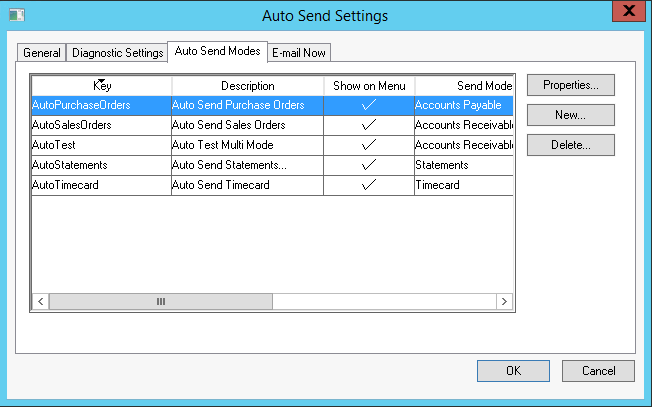
-
Click the New button to create a new Auto Send Mode and open the following dialog, or select a Timecard Auto Send Mode and click the Properties button. Skip to configuration (Step 7) if the mode has already been created:
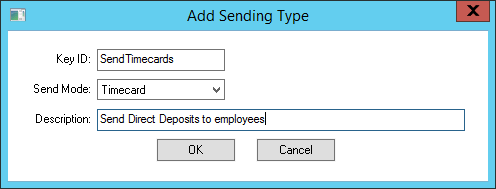
-
Each Auto Send Mode requires a unique Key ID. This Key ID should be a simple descriptive code with no spaces or symbols. (It is permitted to use a mix of uppercase and lowercase letters.)
-
Select Timecard as the Send Mode option. (See image above.)
-
Enter a short Description of the auto send mode type. This description should clearly describe the mode process. Note that this text is used as the EBMS menu label. Click OK to continue. Description examples: "Send direct deposit receipts to workers", "Email payment notices to all employees", etc.
- Click OK to save the new send mode to the Auto Send Modes list.
-
From the Auto Send Modes tab, highlight the Timecard send mode from the list and click the Properties button to open the Send Mode Properties window as shown below:

- Enable the Show on Menu option to display the Timecard Auto Send mode under Labor on the main EBMS menu and enable the batch mode. Disable this option if the Auto Send process is scheduled using Timed Events.
- Click on the Edit Query button to select the group of timecards to be sent as shown below:

The query example shown above will send Direct Deposit Notices for all paid Timecards with a payment method of Direct Deposit. Review the Set Query Options section of the Main documentation for more details on creating query expressions. Click the OK button to save. - Click the View Queried List button to view all timecards that will be sent based on the current query setting as shown below:

The Current Queried List lists all timecards that match the query and have not been previously sent. The Send Date within the timecard must be blank. Click the Purge button to populate the Send Date for all timecards listed and remove them from a query. A purge is often required when a new query is created. Click the Close button. - Maintain the default values within the Fields to Assign settings since they are advanced settings.
- Under Report Settings, add the Individual Direct Deposit Notice report as Report 1. This Report is specifically designed to use with Auto Send. All PDF reports generated with this Auto Send mode should be encrypted. Review the Advanced Settings tab to add an Encryption Password. Click on the Advanced tab to configure the exported PDF Attachment Name.
- Review Auto Send Additional Documents to include other reports with this email.
- The Minimum Report File Size setting: This feature allows you to stop any sends with export files that are below a certain file size. This value should be set at about 10K less than the average exported PDF file size to prohibit blank reports to be sent as an attachment. Please contact Koble Systems support for suggested values on this advanced setting.
- Enable the Attach a copy of the document when auto sending E-mails option to attach a PDF file that is formatted for the worker to print. Note that no document files will be attached if this option is disabled.
- Enable the Export generated PDF's to the temp directory option to record a copy of the document to the temporary directory instead of the shared Export Folder identified in the Auto Send Options > General tab. For security purposes, it is best practice to enable Export generated PDFs to the temp directory for the Timecard send mode. After the batch is sent, all generated PDFs will be deleted from the computer.
- Complete one of the following methods to launch the process to auto send timecards:
-
By selecting Labor > Auto Send Timecard from the main EBMS menu if the Show on menu option is enabled on the Timecard Send Mode Properties.
-
Automatically schedule and send using the File > System Options > Timed Events tab. Review Timed Events to schedule the recurring event.
-
- Click on the Send Mode Properties > Contact Priorities tab as shown below:

- The Auto Send option within EBMS gives the user multiple contact options when sending a document. The listed Contact Priorities are used to prioritize the send options. The priority order is top-down. In the above dialog, Primary Email will be tried first, then general E-mail, with Fax being used when there is no E-mail address listed in the worker's contact list. Complete the following steps to create and order the contact types:
-
Select a send type option as listed below:
-
E-mail: This is the most common send type.
-
CC E-mail: This option will send a carbon copy of the email. This send type can be listed anywhere in the priority list in order to be utilized. The CC E-mail will always be sent if the E-mail send type is priority.
-
Fax: This refers both to faxes (through a modem or fax printer) and email-to-fax sends.
-
-
Select a Contact Type for each send type. The Contact Type is set within the General tab of the worker record. Review Contact Management for more details on changing worker contact labels.
-
- An important setting that must be set to auto send direct deposit forms is the Encryption Password setting within the Auto Send Mode Advanced tab. The last four digits of the worker's social security number can be used by using the employee information syntax used in the E-Mail Settings tab. See example below.
The Advanced tab can also be used to set the PDF Attachment Name created by the reports configured in the Send Mode Properties tab (Report 1, Report 2, etc.). User-defined file names can be set for each of the corresponding reports set in the main tab previously described in this section.
- Click on the Send Mode properties > E-mail Settings tab as shown below:
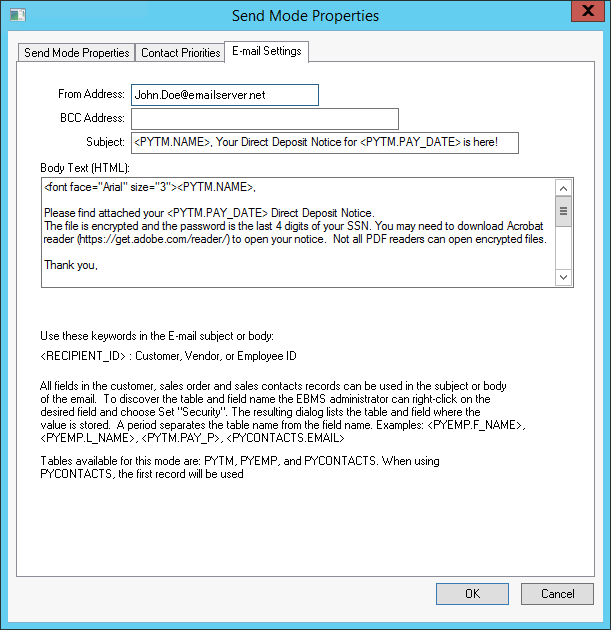
The E-mail Settings determine the details of the email document that will be automatically sent.-
The recommended From Address matches the From Address field on the File > Auto Send Options > General tab. Customer replies will be sent to this email.
-
Use the BCC Address to send a copy of all emails to the worker or department responsible for sending out the Direct Deposit slips so that they can verify that they are going out satisfactorily.
-
Enter an appropriate Subject line for the email broadcast.
-
Enter the appropriate Body Text using HTML or plain text syntax. The keywords list located at the bottom of the dialog can be used within the email body. Note that line break tags (<br />) may cause extra lines in the email.
-
Worker Configuration
Contact information must be set up for all the workers before documents are sent. Go to Labor > Workers from the main EBMS menu and double-click a worker from the list to open the worker record. From the worker record General tab, go to the lower right-hand corner and click on the Contacts tab to view the contact list as shown below. Enter a contact Job Title that matches the setting within the Contact Priorities dialog. Additional contact options can be added to this tab that are not related to any Auto Send modes.
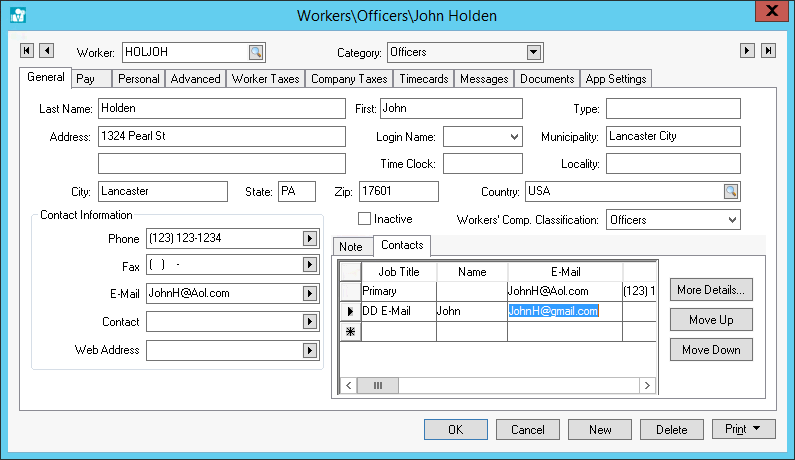
The Auto Send module will only use email and fax contact information.
Review Auto Send Test Mode for a way to put the system in test mode to determine if the settings options are properly set up before automatically sending timecard and payroll information to a group.
Auto Send a Batch of Direct Deposit Notices
Launch the Auto Send feature by selecting Labor > Auto Send Timecard from the main EBMS menu. When the process is launched, it will cycle through the orders that are to be sent based on the settings described in the previous section. A progress bar showing the status of the send process will appear and can run unattended, as no user input should be necessary.
As the system handles each order, it will export a report in PDF format to the Export Folder. This PDF file will then be encrypted and attached to an email or fax and sent to the worker. The PDF attachment can be disabled (not recommended) if the content of the timecard is inserted directly into the main email body. Go to the E-mail Settings tab of the Auto Send Mode dialog to review these options.
If the worker record does not contain any Contact Types which match the entries in the Contact Priorities list, the system will either ignore the order or print it, depending on settings in the Send Mode Properties page. To check, go to File > Auto Send Options > Auto Send Modes > Properties button for a selected send mode. Select this option if some workers do not have email addresses: Document will be printed if employee has no Auto E-mail/Fax entry.
Auto Send Status
Select View > Advanced Options from the timecard menu and click on the Auto Send Status tab to view the status of the Auto Send:
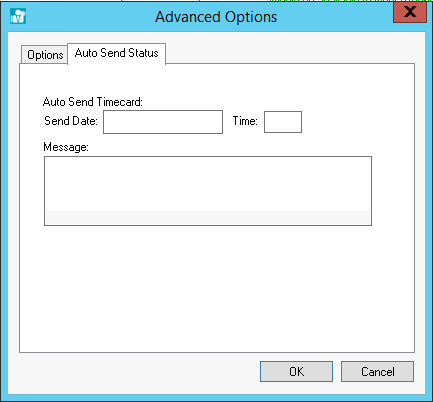
The system will mark the item with the date, time, and a message with the results after the Auto Send process is completed. This useful information gives the user details about the handling of a document by the Auto Send system. Simply eliminate the Send Date value from the document to send it again.